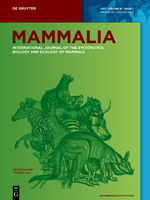View Item
- xmlui.general.dspace_homeCentros Regionales y EEAsCentro Regional Patagonia NorteEEA BarilocheArtículos científicosxmlui.ArtifactBrowser.ItemViewer.trail
- DSpace Home
- Centros Regionales y EEAs
- Centro Regional Patagonia Norte
- EEA Bariloche
- Artículos científicos
- View Item
Influences of pine plantations on small mammal assemblages of the Patagonian forest-steppe ecotone
Abstract
The management of forested landscapes for biodiversity conservation is increasingly recognized as an important objective in Argentina. However, pine plantations are being established replacing native pristine or human modified vegetation and there is a lack of information of its impact on biodiversity. To understand the effect of this activity on small mammal assemblages, we compared its composition and abundance in pine plantations and native vegetation
[ver mas...]
The management of forested landscapes for biodiversity conservation is increasingly recognized as an important objective in Argentina. However, pine plantations are being established replacing native pristine or human modified vegetation and there is a lack of information of its impact on biodiversity. To understand the effect of this activity on small mammal assemblages, we compared its composition and abundance in pine plantations and native vegetation dedicated to traditional cattle production and studied the habitat structure that could explain the differences between habitat types. Additionally, we evaluated the role of firebreaks as corridors in forested landscapes. We found lower abundance and fewer species in plantations. Firebreaks showed a lower abundance and number of species than native vegetation, suggesting that they do not function effectively as corridors. Abrothrix longipilis was the most frequently captured species and abundance of this species was best explained by herbaceous cover and shrub richness. Our results suggest that pine plantations negatively impacts small mammal assemblages and that the decline is strongly associated with decreased understory cover and plant species richness. Management practices targeting conservation objectives such as maintaining lower tree densities and retention of native understory could enhance the value of forest plantations as habitat for small mammal species.
[Cerrar]

Author
Lantschner, Maria Victoria;
Rusch, Veronica Elena;
Hayes, John P.;
Fuente
Mammalia 75 (3) : 249–255 (August 2011)
Date
2011-08
Editorial
De Gruyter
ISSN
0025-1461
1864-1547
1864-1547
Formato
pdf
Tipo de documento
artículo
Palabras Claves
Derechos de acceso
Restringido
 Excepto donde se diga explicitamente, este item se publica bajo la siguiente descripción: Creative Commons Attribution-NonCommercial-ShareAlike 2.5 Unported (CC BY-NC-SA 2.5)
Excepto donde se diga explicitamente, este item se publica bajo la siguiente descripción: Creative Commons Attribution-NonCommercial-ShareAlike 2.5 Unported (CC BY-NC-SA 2.5)

